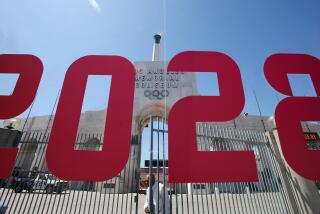Critic’s Notebook: London’s Olympic venues challenge architects
Reporting from London —
One morning about two weeks ago, having made my way from central London to the site of next summer’s Olympic Games, I stood on a wide terrace emerging from the just-completed aquatic center. From the edge of that building, designed by Zaha Hadid and nicknamed the “stingray,” I had a panoramic view of the Olympic Park, which covers 500 acres in a once-industrial section of the Lower Lea Valley, on the eastern edge of London.
The main Olympic Stadium, designed by American firm Populous in collaboration with the British architect Peter Cook, rose directly in front of me. I also had a clear view of Wilkinson Eyre’s basketball venue, a temporary structure made of pillowy white fabric panels. The sleek, cedar-clad form of Hopkins Architects’ velodrome peeked into view to the north.
From a similar vantage point in Beijing, host of the 2008 Olympics, I would have seen a breathtaking main stadium by Herzog and de Meuron, the so-called Bird’s Nest, in the center of a paved plaza of authoritarian scale. In Athens, four years before that, the view would have been of Santiago Caltrava’s white-roofed remake of a 71,000-seat stadium.
But in London, this time around, it is far more than the roster of architects that has changed. Thanks to old-fashioned British reserve and concerns about avoiding the white-elephant syndrome that has plagued many if not most host cities — and also to the sober realities of the economic moment — next year’s Olympics promise to be an exercise, more than anything, in architectural restraint.
Would it be going too far to label these the Austerity Games? Maybe if that title weren’t already taken by the London Olympics of 1948, which were held in a shell-shocked city facing severe postwar shortages of all kinds.
Still, the differences in architectural tone between these games and the 2008 version would be tough to overstate. If the Beijing Olympics were about national pride — about making an announcement, with telegenic architecture, of China’s newfound global muscle — London organizers have concentrated on planning for the post-Olympic future of their site, for what they refer to as its “legacy” condition.
The main stadium is the clearest sign of that spirit of leanness. Ringed by a superstructure of white triangular supports, it’s a building that looks almost unfinished — or like scaffolding for another, more ambitious piece of architecture. But there is undeniably something appealing in a frank, bare-bones way about its proportions and its honesty.
It’s designed as the anti-Bird’s Nest, to be sure — or maybe the nest belonging to a frugal and supremely minimalist bird. But it’s a pretty good building in its own right.
And also one planned very much with the future of the Olympic Park in mind. The stadium will hold 80,000 people during the Olympics, but its upper bowl can be detached and its materials recycled (or used to make another stadium somewhere else). In its permanent, smaller state it will hold 25,000.
Precisely how the transition from big to small will happen, and when, remains the subject of great debate. Two professional soccer clubs have put forward separate plans to adopt the smaller, post-Olympics version as their home stadium. But one, Tottenham Hotspur, signaled a preliminary interest in knocking down the structure and starting from scratch, which didn’t please the folks running the Olympics. The other plan, by West Ham, collapsed last month under the weight of legal challenges.
Although a few sports will be played elsewhere around and outdoors — including archery in the Lord’s Cricket Ground near Regent’s Park — the major venues, most of which are complete, are grouped at the Olympic Park. And if the collection of buildings there has a pragmatic streak, from the perspective of infrastructure and landscape architecture, there is little simple or stripped-down about the 2012 site and its relationship to the rest of London.
The site follows a master plan by the large firm AECOM, which is also helping plan the Rio Summer Olympics in 2016. Populous, which under its old name, HOK Sport, has designed several football and baseball stadiums in the United States, has overseen the various venues, and the landscape architecture team is spearheaded by George Hargreaves. What they’ve produced is the largest urban park to be built anywhere in Europe in 150 years. Located six miles east of central London, directly adjacent to the Stratford underground and rail station, the park occupies a major undeveloped corner of the city that also happens to be tightly connected to the London transit network. The government is spending more than $200 million to upgrade rail links at nearby Stratford Station and in the surrounding area.
Olympic architecture has lurched over the decades from the showy to the practical, from the profligate to the efficient. Los Angeles with the Coliseum in 1932 and Berlin in 1936 were, in different ways, about advertising ambition. Montreal, in 1976, battled massive cost overruns.
If there are forbears to the London plan, they are most easily found in the designs for the 1964 Games in Tokyo, which the Japanese government used as an incentive to produce its first bullet train; the Barcelona Games of 1992, which helped spur an urban revival on the city’s waterfront; and the 1972 Olympics in Munich.
The Munich Games, of course, are remembered for a hostage crisis and the deaths of 11 Israelis. But the architecture of those Games was in some ways a direct precursor to the London approach. The Olympic Stadium, by architect Gunther Behnisch and the terrifically talented engineer Frei Otto, was a lightweight, essentially tented form. In that case the goal was for postwar Germany, less than three decades after the fall of the Nazi regime, to avoid any architectural gestures that might be seen as aggressive or self-aggrandizing. The stadium continues to be used.
In London’s case the practicality of the architecture is a reaction to the economic rather than the political excesses of the recent past. The 2012 Games are shaping up, in fact, as one of the clearest signs yet that the architectural boom years of the last decade or so in the West have definitively ended.
That’s not to say there is no such thing as a boom time hangover. And in fact if there is one venue that suggests the difficulties of this transition, it is the aquatic center. After I took in the broad Olympic panorama from its terrace, I headed back inside to walk through Hadid’s building.
Like the Olympic Stadium, the aquatic center is designed in two sections, one permanent and one temporary. The legacy version, which will seat 3,000, is typical Hadid: a stunning column-free interior beneath an undulating roof, with diving platforms that look like liquid sculpture.
Attached to that virtuosic and hugely expensive design — total construction costs were about $440 million, even after major changes were made to the original scheme — is a pair of temporary grandstands. Made of PVC fabric stretched between a series of massive, unadorned staircases, the grandstands will add 14,500 seats to the capacity of the aquatic center during the Olympics. Some in the British press have openly asked why the roof of the streamlined velodrome — already emerging as the critical favorite among the venues — managed by using a cable-net system to cover nearly the same roof span while using about one-tenth as much steel.
Fairly or not, Hadid has become one of the leading symbols of the architectural overreach of the last decade. And while she has a bit of experience with temporary structures, they have not been of the low-key variety: Her portable “mobile art pavilion” for Chanel, which traveled around the world in 2009, was viewed in some quarters as a let-them-eat-cake response to the growing interest among young architects in truly minimal temporary architecture.
In the case of Hadid’s aquatic center, you could say that the transition between the temporary stands and the permanent venue is awkward. But that would suggest that there is a transition. Instead, two kinds of architecture — two ways of looking at the world, really — are rather rudely mashed together.
The temporary stands have been compared in the British press to saddle bags. And in fact they do seem to weigh on the building below, like a kind of architectural guilt. Let the rampant armchair psychoanalysis of the starchitecture era continue!
christopher.hawthorne@latimes.com
More to Read
The biggest entertainment stories
Get our big stories about Hollywood, film, television, music, arts, culture and more right in your inbox as soon as they publish.
You may occasionally receive promotional content from the Los Angeles Times.







